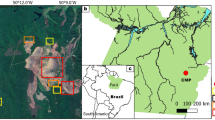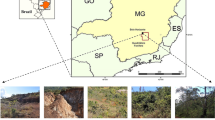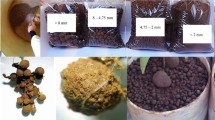Abstract
The revegetation of areas impacted by iron mining may be hampered by a series of chemical and physical impediments exhibited by those areas. Physical problems, such as penetration resistance and steep slopes, may outweigh the chemical problems, such that both should be considered for soil recovery. This study aimed to evaluate the main soil attributes that are directly related to plant growth on areas affected by iron mining activities discussing possible solutions. For this purpose, chemical and physical attributes including penetration resistance on open pit mines, waste piles and native forest in Carajás Mineral Province were analysed. The results show that the open pits had low to medium levels of P and low levels of organic matter and of the micronutrients B, Zn and Cu. In the waste piles, the chemical parameters were less hindering than in the open pits. Soil penetration resistance in open pits was higher than in the waste piles and the forest; however, there was a reduction of up to 69% in soil resistance in open pits in the rainy season. The principal chemical problems observed in mine pits can be easily corrected, although the inclination of open pit slopes in combination with elevated soil density increase the risks of losses of fertilizers and seeds by runoff. Penetration resistance is the most serious problem for the development of plants in mine pits, although the use of irrigation water can help to maintain tolerable levels of resistance in soil for proper root growth of native species.




Similar content being viewed by others
Data availability
The data sets supporting the results of this article are included within the article and its additional files.
References
Abbaslou H, Bakhtiari S, Hashemi SS (2018) Rehabilitation of iron ore mine soil contaminated with heavy metals using rosemary phytoremediation-assisted mycorrhizal arbuscular fungi bioaugmentation and fibrous clay mineral immobilization. Iran J Sci Technol Trans A Sci 42:431–441. https://doi.org/10.1007/s40995-018-0543-7
Alvarez VH, Novais RF, Barros NF et al (1999) Interpretação dos resultados das análises de solos. In: Ribeiro AC, Guimarães PTG, Alvarez VH (eds) Recomendações para o uso de corretivos e fertilizantes em Minas Gerais—5° aproximação. CFSEMG, Viçosa, p 359
Arshad MA, Lowery B, Grossman B (1996) Physicaltests for monitoring soil quality. In: Doran JW, Jones AJ (eds) Methods for assessing of soil quality. Soil Science Society of American/AmericanSociety of Agronomy, Madison, pp 123–141
Asensio V, Vega FA, Andrade ML, Covelo EF (2013) Tree vegetation and waste amendments to improve the physical condition of copper mine soils. Chemosphere 90:603–610. https://doi.org/10.1016/j.chemosphere.2012.08.050
Banerjee R, Goswami P, Mukherjee A (2018) Stabilization of iron ore mine spoil dump sites with vetiver system. Bio-geotechnologies for mine site rehabilitation. Elsevier, Amsterdam, pp 393–413
Beltrame LFS, Gondin LAP, Taylor JC (1981) Estrutura e compactação na permeabilidade de solos do Rio Grande do Sul. Rev Bras Ciência Do Solo 5:145–149
Camargo OA, Moniz AC, Jorge JA, Valadares JMAS (2009) Métodos de análise química, mineralógica e física de solos do IAC. Instituto Agronômico de Campinas, Campinas
Chen YL, Palta J, Clements J et al (2014) Root architecture alteration of narrow-leafed lupin and wheat in response to soil compaction. F Crop Res 165:61–70. https://doi.org/10.1016/j.fcr.2014.04.007
Chirino E, Vilagrosa A, Hernández EI et al (2008) Effects of a deep container on morpho-functional characteristics and root colonization in Quercus suber L. seedlings for reforestation in Mediterranean climate. For Ecol Manage 256:779–785. https://doi.org/10.1016/j.foreco.2008.05.035
Colombi T, Keller T (2019) Developing strategies to recover crop productivity after soil compaction—a plant eco-physiological perspective. Soil Tillage Res 191:156–161. https://doi.org/10.1016/j.still.2019.04.008
Colombi T, Torres LC, Walter A, Keller T (2018) Feedbacks between soil penetration resistance, root architecture and water uptake limit water accessibility and crop growth—a vicious circle. Sci Total Environ 626:1026–1035. https://doi.org/10.1016/j.scitotenv.2018.01.129
Cravo MS, Viégas IJM, Brasil EC (2010) Recomendações de adubação e calagem para o Estado do Pará, 1st edn. Embrapa Amazônia Oriental, Belém
Das D, Dwivedi BS, Datta SP et al (2019) Potassium supplying capacity of a red soil from eastern India after forty-two years of continuous cropping and fertilization. Geoderma 341:76–92. https://doi.org/10.1016/j.geoderma.2019.01.041
Domínguez-Haydar Y, Velásquez E, Carmona J et al (2019) Evaluation of reclamation success in an open-pit coal mine using integrated soil physical, chemical and biological quality indicators. Ecol Indic 103:182–193. https://doi.org/10.1016/j.ecolind.2019.04.015
Dultz S, Steinke H, Mikutta R et al (2018) Impact of organic matter types on surface charge and aggregation of goethite. Colloids Surf A Physicochem Eng Asp 554:156–168. https://doi.org/10.1016/j.colsurfa.2018.06.040
Dunalska JA, Górniak D, Jaworska B, Gaiser EE (2012) Effect of temperature on organic matter transformation in a different ambient nutrient availability. Ecol Eng 49:27–34. https://doi.org/10.1016/j.ecoleng.2012.08.023
Duncan JM, Wright SG, Brandon TL (2014) Soil strength and slope stability. In: Hoboken NJ 2nd edition, Wiley
Eick MJ, Bar-tal A, Sparks DL, Feigenbaum S (1990) Analyses of adsorption kinetics using a stirred-flow chamber: II. Potassium-calcium exchange on clay minerals. Soil Sci Soc Am J 54:1278–1282. https://doi.org/10.2136/sssaj1990.03615995005400050013x
Embrapa (2017) Manual de métodos de análise de solo, 3rd edn. Embrapa Solos, Rio de Janeiro
Feng Y, Wang J, Bai Z, Reading L (2019) Effects of surface coal mining and land reclamation on soil properties: a review. Earth-Sci Rev 191:12–25. https://doi.org/10.1016/j.earscirev.2019.02.015
Fertahi S, Bertrand I, Ilsouk M et al (2019) New generation of controlled release phosphorus fertilizers based on biological macromolecules: effect of formulation properties on phosphorus release. Int J Biol Macromol. https://doi.org/10.1016/J.IJBIOMAC.2019.12.005
Fields-Johnson CW, Zipper CE, Burger JA, Evans DM (2012) Forest restoration on steep slopes after coal surface mining in Appalachian USA: Soil grading and seeding effects. For Ecol Manage 270:126–134. https://doi.org/10.1016/j.foreco.2012.01.018
Fink JR, Inda AV, Bavaresco J et al (2016) Phosphorus adsorption and desorption in undisturbed samples from subtropical soils under conventional tillage or no-tillage. J Plant Nutr Soil Sci. https://doi.org/10.1002/jpln.201500017
Fujita K, Miyabara Y, Kunito T (2019) Microbial biomass and ecoenzymatic stoichiometries vary in response to nutrient availability in an arable soil. Eur J Soil Biol. https://doi.org/10.1016/j.ejsobi.2018.12.005
Gastauer M, Souza Filho PWM, Ramos SJ et al (2019) Mine land rehabilitation in Brazil: Goals and techniques in the context of legal requirements. Ambio 48:74–88. https://doi.org/10.1007/s13280-018-1053-8
Geoscience-Australia (2016) Australian mines atlas. http://www.australianminesatlas.gov.au/
Gomes M, Ferreira RL, de Ruchkys ÚA (2019) Landscape evolution in ferruginous geosystems of the Iron Quadrangle, Brazil: a speleological approach in a biodiversity hotspot. SN Appl Sci 1:1102. https://doi.org/10.1007/s42452-019-1139-3
Guedes RS, Ramos SJ, Gastauer M et al (2020) Phosphorus lability increases with the rehabilitation advance of iron mine land in the eastern Amazon. Environ Monit Assess 192:390. https://doi.org/10.1007/s10661-020-08365-4
Gülser C, Candemir F (2012) Changes in penetration resistance of a clay field with organic waste applications. Eurasian J Soil Sci 1:16–21. https://doi.org/10.18393/ejss.03364
Haldar SK (2013) Elements of mining. Mineral exploration. Elsevier, Amsterdam, pp 193–222
Hu Z, Zhu Q, Liu X, Li Y (2020) Preparation of topsoil alternatives for open-pit coal mines in the Hulunbuir grassland area. China Appl Soil Ecol 147:103431. https://doi.org/10.1016/j.apsoil.2019.103431
IBRAM (2013) Information and analysis on the brazilian mineral economy. 7th edition. In: Brazilian Min. Assoc. www.ibram.org.br. Accessed 15 Jan 2020
Jing X, Chen X, Fang J et al (2020) Soil microbial carbon and nutrient constraints are driven more by climate and soil physicochemical properties than by nutrient addition in forest ecosystems. Soil Biol Biochem 141:107657. https://doi.org/10.1016/j.soilbio.2019.107657
Kuznetsova A, Brockhoff PB, Christensen RHB (2017) lmerTest package: tests in linear mixed effects models. J Stat Softw 82:1–26. https://doi.org/10.18637/jss.v082.i13
Lamb D, Sanderson P, Wang L et al (2017) Phytocapping of mine waste at derelict mine sites in New South Wales. Spoil to soil. CRC Press, Boca Raton, pp 215–239
Lei H, Peng Z, Yigang H, Yang Z (2016) Vegetation and soil restoration in refuse dumps from open pit coal mines. Ecol Eng 94:638–646. https://doi.org/10.1016/j.ecoleng.2016.06.108
Liu X, Zhou W, Bai Z (2016) Vegetation coverage change and stability in large open-pit coal mine dumps in China during 1990–2015. Ecol Eng 95:447–451. https://doi.org/10.1016/j.ecoleng.2016.06.051
Liu G, Hu F, Zheng F, Zhang Q (2019) Effects and mechanisms of erosion control techniques on stairstep cut-slopes. Sci Total Environ 656:307–315. https://doi.org/10.1016/j.scitotenv.2018.11.385
Martins GC, Penido ES, Alvarenga IFS et al (2018) Amending potential of organic and industrial by-products applied to heavy metal-rich mining soils. Ecotoxicol Environ Saf 162:581–590. https://doi.org/10.1016/J.ECOENV.2018.07.040
Mayes WM, Johnston D, Potter HAB, Jarvis AP (2009) A national strategy for identification, prioritisation and management of pollution from abandoned non-coal mine sites in England and Wales. I. Methodology development and initial results. Sci Total Environ 407:5435–5447. https://doi.org/10.1016/j.scitotenv.2009.06.019
Mehlich A (1953) Determination of P, Ca, Mg, K, Na, and NH4. University of N, Carolina, Raleigh
Miller VS, Naeth MA (2019) Hydrogel and organic amendments to increase water retention in anthroposols for land reclamation. Appl Environ Soil Sci 2019:1–11. https://doi.org/10.1155/2019/4768091
Mohieddinne H, Brasseur B, Spicher F et al (2019) Physical recovery of forest soil after compaction by heavy machines, revealed by penetration resistance over multiple decades. For Ecol Manage 449:117472. https://doi.org/10.1016/j.foreco.2019.117472
Mukhopadhyay S, Masto RE, Tripathi RC, Srivastava NK (2019) Application of soil quality indicators for the phytorestoration of mine spoil dumps. Phytomanagement of polluted sites. Elsevier, Amsterdam, pp 361–388
Ondrasek G, Bakić Begić H, Zovko M et al (2019) Biogeochemistry of soil organic matter in agroecosystems & environmental implications. Sci Total Environ 658:1559–1573. https://doi.org/10.1016/J.SCITOTENV.2018.12.243
Pinheiro J, Bates D, DebRoy S, et al (2020) nlme: linear and nonlinear mixed effects models. R package version 3.1–145
Pinto JR, Marshall JD, Dumroese RK et al (2011) Establishment and growth of container seedlings for reforestation: a function of stocktype and edaphic conditions. For Ecol Manage 261:1876–1884. https://doi.org/10.1016/j.foreco.2011.02.010
Qin H, Chen J, Wu Q et al (2017) Intensive management decreases soil aggregation and changes the abundance and community compositions of arbuscular mycorrhizal fungi in Moso bamboo (Phyllostachys pubescens) forests. For Ecol Manage 400:246–255. https://doi.org/10.1016/j.foreco.2017.06.003
Quesada CA, Lloyd J, Anderson LO et al (2011) Soils of Amazonia with particular reference to the RAINFOR sites. Biogeosciences 8:1415–1440. https://doi.org/10.5194/bg-8-1415-2011
R Core Team (2018) R: a language and environment for statistical computing
Reinert DJ, Albuquerque JA, Reichert JM et al (2008) Limites críticos de densidade do solo para o crescimento de raízes de plantas de cobertura em argissolo vermelho. Rev Bras Ciência Do Solo 32:1805–1816. https://doi.org/10.1590/S0100-06832008000500002
Sarkar B, Wijesekara H, Mandal S et al (2017) Characterization and improvement in physical, chemical, and biological properties of mine wastes. In: Bolan NS, Kirkham MB, Ok YS (eds) Spoil to soil: mine site rehabilitation and revegetation, 1st edn. CRC Press, Boca Raton, pp 3–15
Sinha N, Deb D, Pathak K (2017) Development of a mining landscape and assessment of its soil erosion potential using GIS. Eng Geol 216:1–12. https://doi.org/10.1016/j.enggeo.2016.10.012
Soucek DJ, Cherry DS, Currie RJ et al (2000) Laboratory to field validation in an integrative assessment of an acid mine drainage-impacted watershed. Environ Toxicol Chem 19:1036–1043. https://doi.org/10.1002/etc.5620190433
Souza R, Hartzell S, Freire Ferraz AP et al (2021) Dynamics of soil penetration resistance in water-controlled environments. Soil Tillage Res 205:104768. https://doi.org/10.1016/j.still.2020.104768
Stolf R (1991) Teoria e teste experimental de fórmulas detransformação dos dados de penetrômetro de impactoem resistência do solo. Rev Bras Cienc Do Solo 15:229–235
Stolf R, Fernandes J, Furlani NV (1983) Penetrômetro de impacto modelo IAA/Planalsucar-Stolf: recomendação para seu uso. STAB 1:18–23
Tedesco MJ, Gianello C, Anghinoni I et al (2004) Manual de adubação e de calagem para os Estados do Rio Grande do Sul e de Santa Catarina, 10th edn. SBCS—Sociedade Brasileira de Ciência Do Solo. Núcleo Regional Sul, Porto Alegre
Touceda-González M, Álvarez-López V, Prieto-Fernández Á et al (2017) Aided phytostabilisation reduces metal toxicity, improves soil fertility and enhances microbial activity in Cu-rich mine tailings. J Environ Manag 186:301–313. https://doi.org/10.1016/j.jenvman.2016.09.019
Treschevskaya E, Tichonova E, Golyadkina I, Malinina T (2019) Soil development processes under different tree species at afforested post-mining sites. IOP Conf Ser Earth Environ Sci 226:012012. https://doi.org/10.1088/1755-1315/226/1/012012
Upadhyay RK, Asokan S, Venkatesh AS (2011) Mode of occurrence of phosphorus in iron ores of eastern limb, Bonai Synclinorium, eastern India. J Geol Soc India 77:549–556. https://doi.org/10.1007/s12594-011-0054-z
Vasquez ML, Rosa-Costa LT (2008) Geologia e recursos minerais do estado do Pará: sistema de informações geográficas—SIG: texto explicativo dos mapas geológico e tectônico e de recursos minerais do estado do Pará. Escala 1:1.000.000. CPRM, Belém
Veiga M, Horn R, Reinert DJ, Reichert JM (2007) Soil compressibility and penetrability of an Oxisol from southern Brazil, as affected by long-term tillage systems. Soil Tillage Res 92:104–113. https://doi.org/10.1016/J.STILL.2006.01.008
Wijesekara H, Bolan NS, Colyvas K et al (2017) Use of biowaste for mine site rehabilitation a meta-analysis on soil carbon dynamics. In: Bolan NS, Kirkham MB, Ok YS (eds) Spoil to soil. CRC Press, Taylor & Francis Group, Boca Raton, FL, pp 59–74 (6000 Broken Sound Parkway NW, Suite 300, 33487-2742)
Zhao X, Li Z, Zhu D et al (2018) Revegetation using the deep planting of container seedlings to overcome the limitations associated with topsoil desiccation on exposed steep earthy road slopes in the semiarid loess region of China. L Degrad Dev 29:2797–2807. https://doi.org/10.1002/ldr.2988
Zhao Z, Chang E, Lai P et al (2019) Evolution of soil surface charge in a chronosequence of paddy soil derived from Alfisol. Soil Tillage Res 192:144–150. https://doi.org/10.1016/j.still.2019.05.011
Acknowledgements
The authors would like to thank the National Council of Technology and Scientific Development (CNPq) and the Coordination for the Improvement of Higher Education Personnel (CAPES) and the Vale Institute of Technology (ITV) for financial support in the development of this work and for the scholarships provided.
Funding
This work was financially supported by the National Council of Technology and Scientific Development (CNPq), Project number 402726/2018-9.
Author information
Authors and Affiliations
Corresponding author
Ethics declarations
Conflict of interest
The authors declare that they have no conflict of interest.
Ethical approval
Not applicable.
Consent to participate
Not applicable.
Consent to publish
Not applicable.
Additional information
Publisher's Note
Springer Nature remains neutral with regard to jurisdictional claims in published maps and institutional affiliations.
Supplementary Information
Below is the link to the electronic supplementary material.
Rights and permissions
About this article
Cite this article
Guedes, R.S., Ramos, S.J., Gastauer, M. et al. Challenges and potential approaches for soil recovery in iron open pit mines and waste piles. Environ Earth Sci 80, 640 (2021). https://doi.org/10.1007/s12665-021-09926-7
Received:
Accepted:
Published:
DOI: https://doi.org/10.1007/s12665-021-09926-7




